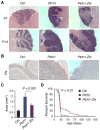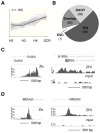Zfx facilitates tumorigenesis caused by activation of the Hedgehog pathway
- PMID: 25164012
- PMCID: PMC4199880
- DOI: 10.1158/0008-5472.CAN-14-0834
Zfx facilitates tumorigenesis caused by activation of the Hedgehog pathway
Abstract
The Hedgehog (Hh) signaling pathway regulates normal development and cell proliferation in metazoan organisms, but its aberrant activation can promote tumorigenesis. Hh-induced tumors arise from various tissues and they may be indolent or aggressive, as is the case with skin basal cell carcinoma (BCC) or cerebellar medulloblastoma, respectively. Little is known about common cell-intrinsic factors that control the development of such diverse Hh-dependent tumors. Transcription factor Zfx is required for the self-renewal of hematopoietic and embryonic stem cells, as well as for the propagation of acute myeloid and T-lymphoblastic leukemias. We report here that Zfx facilitates the development of experimental BCC and medulloblastoma in mice initiated by deletion of the Hh inhibitory receptor Ptch1. Simultaneous deletion of Zfx along with Ptch1 prevented BCC formation and delayed medulloblastoma development. In contrast, Zfx was dispensable for tumorigenesis in a mouse model of glioblastoma. We used genome-wide expression and chromatin-binding analysis in a human medulloblastoma cell line to characterize direct, evolutionarily conserved targets of Zfx, identifying Dis3L and Ube2j1 as two targets required for the growth of the human medulloblastoma cells. Our results establish Zfx as a common cell-intrinsic regulator of diverse Hh-induced tumors, with implications for the definition of new therapeutic targets in these malignancies.
©2014 American Association for Cancer Research.
Conflict of interest statement
The authors declare no conflict of interest.
Figures







Similar articles
-
Pituitary adenylyl cyclase activating polypeptide inhibits gli1 gene expression and proliferation in primary medulloblastoma derived tumorsphere cultures.BMC Cancer. 2010 Dec 9;10:676. doi: 10.1186/1471-2407-10-676. BMC Cancer. 2010. PMID: 21143927 Free PMC article.
-
Characteristic overexpression of the forkhead box transcription factor Foxf1 in Patched-associated tumors.Int J Mol Med. 2008 Dec;22(6):787-92. Int J Mol Med. 2008. PMID: 19020777
-
Patched1 inhibits epidermal progenitor cell expansion and basal cell carcinoma formation by limiting Igfbp2 activity.Cancer Prev Res (Phila). 2010 Oct;3(10):1222-34. doi: 10.1158/1940-6207.CAPR-10-0082. Epub 2010 Sep 21. Cancer Prev Res (Phila). 2010. PMID: 20858761
-
Clinical implications of hedgehog signaling pathway inhibitors.Chin J Cancer. 2011 Jan;30(1):13-26. doi: 10.5732/cjc.010.10540. Chin J Cancer. 2011. PMID: 21192841 Free PMC article. Review.
-
Interaction of hedgehog and vitamin D signaling pathways in basal cell carcinomas.Adv Exp Med Biol. 2014;810:329-41. doi: 10.1007/978-1-4939-0437-2_18. Adv Exp Med Biol. 2014. PMID: 25207374 Review.
Cited by
-
Zfx-induced upregulation of UBE2J1 facilitates endometrial cancer progression via PI3K/AKT pathway.Cancer Biol Ther. 2021 Mar 4;22(3):238-247. doi: 10.1080/15384047.2021.1883186. Epub 2021 Feb 26. Cancer Biol Ther. 2021. PMID: 33632059 Free PMC article.
-
UBE2J1 inhibits colorectal cancer progression by promoting ubiquitination and degradation of RPS3.Oncogene. 2023 Feb;42(9):651-664. doi: 10.1038/s41388-022-02581-7. Epub 2022 Dec 26. Oncogene. 2023. PMID: 36567344 Free PMC article.
-
Zinc and zinc-containing biomolecules in childhood brain tumors.J Mol Med (Berl). 2016 Nov;94(11):1199-1215. doi: 10.1007/s00109-016-1454-8. Epub 2016 Sep 16. J Mol Med (Berl). 2016. PMID: 27638340 Review.
-
How hydrolytic exoribonucleases impact human disease: Two sides of the same story.FEBS Open Bio. 2023 Jun;13(6):957-974. doi: 10.1002/2211-5463.13392. Epub 2022 Mar 20. FEBS Open Bio. 2023. PMID: 35247037 Free PMC article. Review.
-
ZFX is a Strong Predictor of Poor Prognosis in Renal Cell Carcinoma.Med Sci Monit. 2015 Nov 5;21:3380-5. doi: 10.12659/msm.894708. Med Sci Monit. 2015. PMID: 26540164 Free PMC article.
References
-
- Hooper JE, Scott MP. Communicating with Hedgehogs. Nat Rev Mol Cell Biol. 2005;6:306–17. - PubMed
-
- Ingham PW, Nakano Y, Seger C. Mechanisms and functions of Hedgehog signalling across the metazoa. Nat Rev Genet. 2011;12:393–406. - PubMed
-
- Lum L, Beachy PA. The Hedgehog Response Network: Sensors, Switches, and Routers. Science. 2004;304:1755–9. - PubMed
-
- Varjosalo M, Taipale J. Hedgehog: functions and mechanisms. Genes & Development. 2008;22:2454–72. - PubMed
-
- Kenney AM, Cole MD, Rowitch DH. Nmyc upregulation by sonic hedgehog signaling promotes proliferation in developing cerebellar granule neuron precursors. Development. 2003;130:15–28. - PubMed
Publication types
MeSH terms
Substances
Grants and funding
LinkOut - more resources
Full Text Sources
Other Literature Sources
Molecular Biology Databases
Research Materials
Miscellaneous

